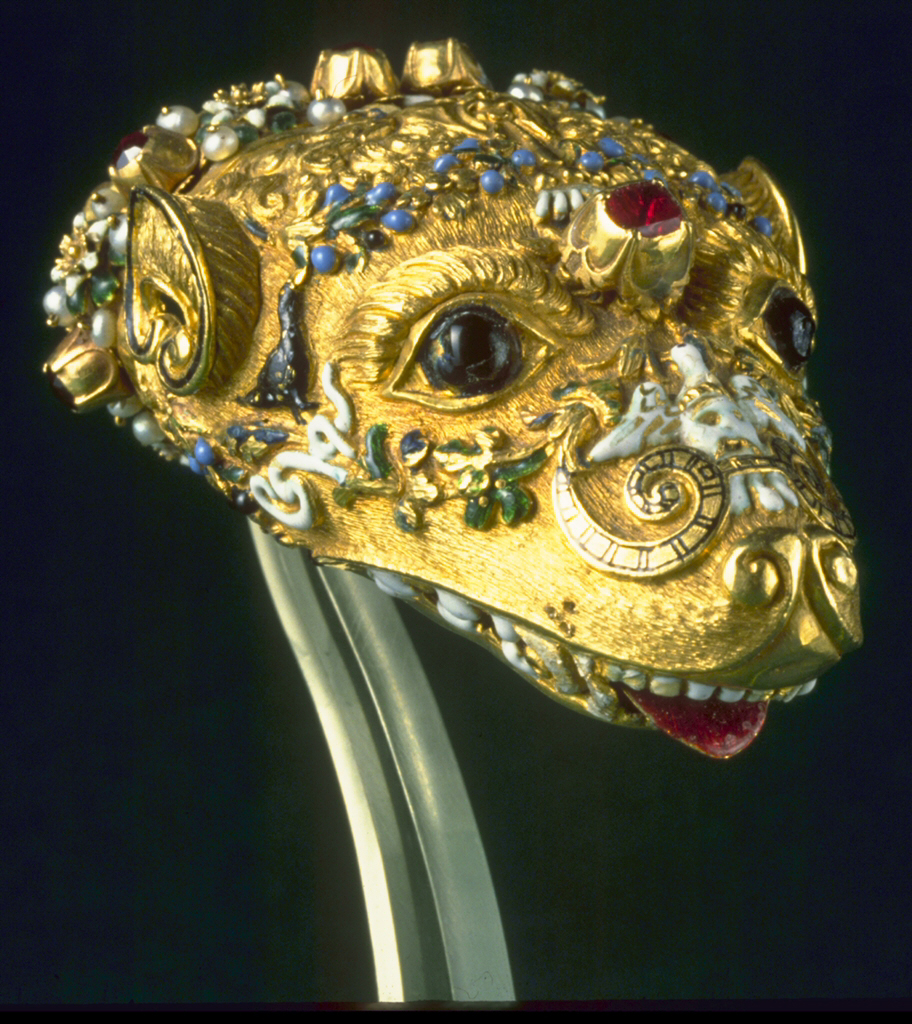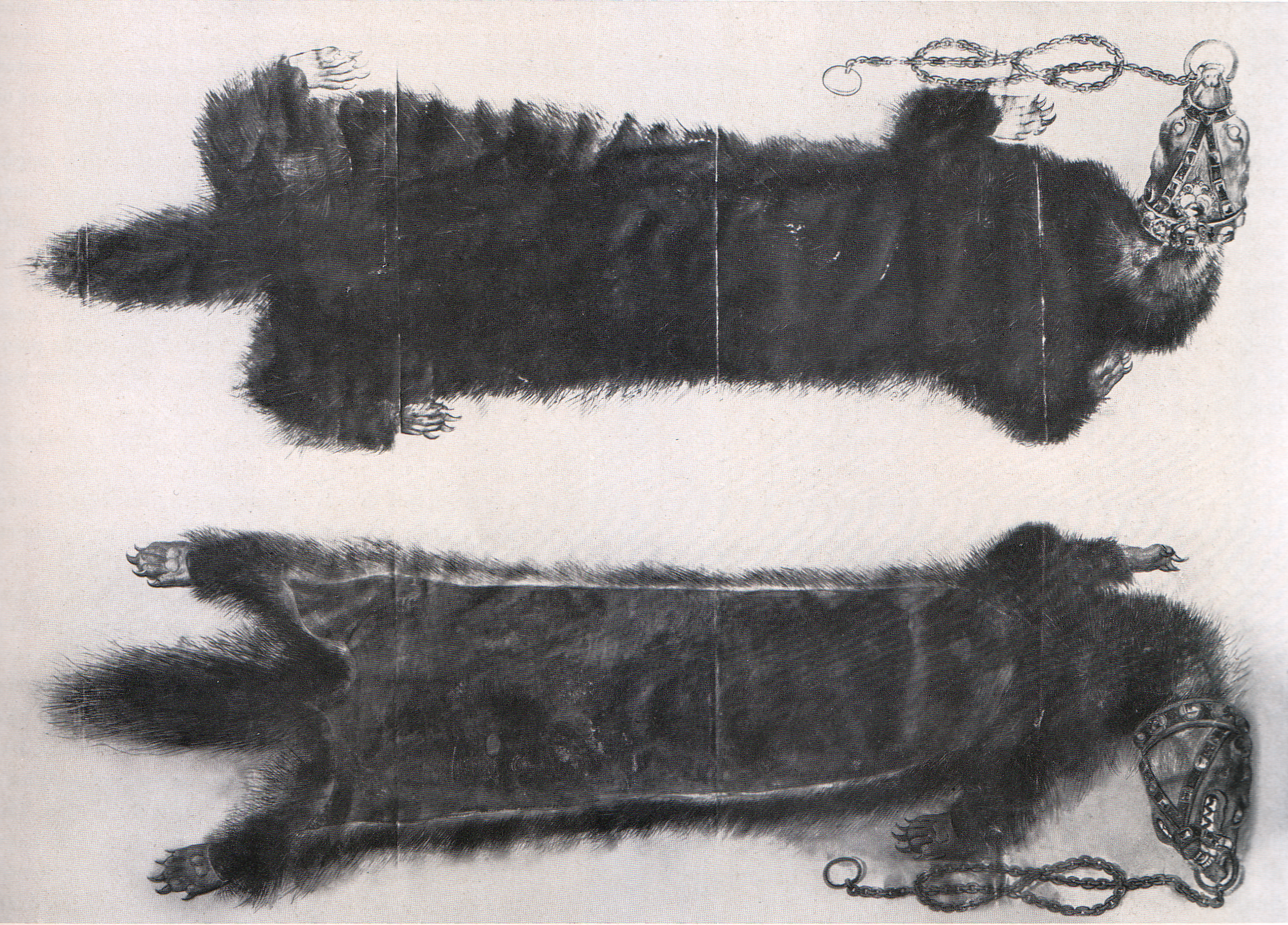Zibellino del Barguzin (1).jpg on:
[Wikipedia]
[Google]
[Amazon]
A zibellino, flea-fur or fur tippet is a women's fashion accessory popular in the later 15th and 16th centuries. A zibellino, from the Italian word for "


 The earliest surviving mention of a marten pelt to be worn as neck ornament occurs in an inventory of Charles the Bold, Duke of Burgundy, dated 1467, but the fashion was widespread in Northern Italy by the 1490s. Eleonora de Toledo owned at least four; the weasel was an early modern talisman for fertility and Leonora was applauded as ''La Fecondissima'', "most fertile" for the number of her children. Eleonora's daughter
The earliest surviving mention of a marten pelt to be worn as neck ornament occurs in an inventory of Charles the Bold, Duke of Burgundy, dated 1467, but the fashion was widespread in Northern Italy by the 1490s. Eleonora de Toledo owned at least four; the weasel was an early modern talisman for fertility and Leonora was applauded as ''La Fecondissima'', "most fertile" for the number of her children. Eleonora's daughter
Image:Bernardino Luini Lady with a Flea Fur.jpg, Italy, 1515
File:Paolo Veronese - Portrait of Countess Livia da Porto Thiene and her Daughter Deidamia - Walters 37541.jpg, Italy, 1552.
File:Portrait of Bianca Ponzoni Anguissola, by Sofonisba Anguissola.jpg, Italy 1557
File:Isabella de' Medici 02.jpg, Isabella de' Medici, Italy, 1558
Image:Clouet Claude de Chateaubrun.jpg, France, mid-16th century
File:Portrait of a Lady in Black with a Fur.jpg, probably England, mid-16th century
File:Frances Sydney Countess of Sussex.jpg, England, ca. 1570-75
Image:Isabel de Valois2..jpg, Elisabeth of Valois, Spain, 1560s
Zibellini (aka "Flea Furs") in 16th Century Portraits
Gold and jewelled marten's head from the Walters Art Museum, Baltimore
History of clothing (Western fashion) Fashion accessories Fur
sable
The sable (''Martes zibellina'') is a species of marten, a small omnivorous mammal primarily inhabiting the forest environments of Russia, from the Ural Mountains throughout Siberia, and northern Mongolia. Its habitat also borders eastern Kaza ...
", is the pelt of a sable or marten
A marten is a weasel-like mammal in the genus ''Martes'' within the subfamily Guloninae, in the family Mustelidae. They have bushy tails and large paws with partially retractile claws. The fur varies from yellowish to dark brown, depending on t ...
worn draped at the neck or hanging at the waist, or carried in the hand. The plural is ''zibellini''. Some zibellini were fitted with faces and paws of goldsmith's work with jeweled eyes and pearl earring
An earring is a piece of jewelry attached to the ear via a piercing in the earlobe or another external part of the ear (except in the case of clip earrings, which clip onto the lobe). Earrings have been worn by people in different civilizations an ...
s, while unadorned furs were also fashionable.Sherrill, Tawny: "Fleas, Furs, and Fashions: ''Zibellini'' as Luxury Accessories of the Renaissance", in Robin Netherton and Gale R. Owen-Crocker, editors, ''Medieval Clothing and Textiles'', Volume 2, p. 121-150
History


 The earliest surviving mention of a marten pelt to be worn as neck ornament occurs in an inventory of Charles the Bold, Duke of Burgundy, dated 1467, but the fashion was widespread in Northern Italy by the 1490s. Eleonora de Toledo owned at least four; the weasel was an early modern talisman for fertility and Leonora was applauded as ''La Fecondissima'', "most fertile" for the number of her children. Eleonora's daughter
The earliest surviving mention of a marten pelt to be worn as neck ornament occurs in an inventory of Charles the Bold, Duke of Burgundy, dated 1467, but the fashion was widespread in Northern Italy by the 1490s. Eleonora de Toledo owned at least four; the weasel was an early modern talisman for fertility and Leonora was applauded as ''La Fecondissima'', "most fertile" for the number of her children. Eleonora's daughter Isabella de' Medici
Isabella Romola de' Medici (31 August 1542 – 16 July 1576) was the daughter of Cosimo I de' Medici, first Grand Duke of Tuscany, and Eleonora di Toledo. She was raised and educated in a humanist manner with her siblings, including Francesco de' ...
appears with a ''zibellino'' in a portrait by a member of Bronzino
Agnolo di Cosimo (; 17 November 150323 November 1572), usually known as Bronzino ( it, Il Bronzino ) or Agnolo Bronzino, was an Italian Mannerist painter from Florence. His sobriquet, ''Bronzino'', may refer to his relatively dark skin or reddis ...
's studio painted at the time of her marriage in 1558 to Paolo Giordano Orsini.
The style spread to the north and west. The traditional costume historian's term for this accessory, flea-fur, is from the German
German(s) may refer to:
* Germany (of or related to)
**Germania (historical use)
* Germans, citizens of Germany, people of German ancestry, or native speakers of the German language
** For citizens of Germany, see also German nationality law
**Ger ...
''Flohpelz'', coined by Wendelin Boeheim in 1894, who was the first to suggest that the furs were intended to attract fleas away from the body of the wearer. There is no historical evidence to support this claim. Italians simply called these accessories "zibellini", their word for sables and speakers of other languages called them "martens", "sables" or "ermines" in their native tongues.
The fashion for carrying zibellini died out in the first years of the 17th century, although fox
Foxes are small to medium-sized, omnivorous mammals belonging to several genera of the family Canidae. They have a flattened skull, upright, triangular ears, a pointed, slightly upturned snout, and a long bushy tail (or ''brush'').
Twelve sp ...
, mink
Mink are dark-colored, semiaquatic, carnivorous mammals of the genera ''Neogale'' and '' Mustela'' and part of the family Mustelidae, which also includes weasels, otters, and ferrets. There are two extant species referred to as "mink": the A ...
and other pelts were worn in similar fashion in the 19th and 20th century.
England and Scotland
The jewelled gold heads and feet of zibellini were detailed in several royal inventories. The Edinburgh goldsmith John Mosman made a marten's head and feet from Scottish gold forMary of Guise
Mary of Guise (french: Marie de Guise; 22 November 1515 – 11 June 1560), also called Mary of Lorraine, was a French noblewoman of the House of Guise, a cadet branch of the House of Lorraine and one of the most powerful families in France. She ...
in December 1539. Her daughter, Mary, Queen of Scots, brought fur pieces on her return to Scotland from France in 1561; one of her zibellini had a head of jet
Jet, Jets, or The Jet(s) may refer to:
Aerospace
* Jet aircraft, an aircraft propelled by jet engines
** Jet airliner
** Jet engine
** Jet fuel
* Jet Airways, an Indian airline
* Wind Jet (ICAO: JET), an Italian airline
* Journey to Enceladus a ...
.
In England, when Lady Jane Grey
Lady Jane Grey ( 1537 – 12 February 1554), later known as Lady Jane Dudley (after her marriage) and as the "Nine Days' Queen", was an English noblewoman who claimed the throne of England and Ireland from 10 July until 19 July 1553.
Jane was ...
was at the Tower of London in 1553, she had a "sable skin, with a head of gold, muffled, garnished and set with four emeralds, four turquoises, six rubies, two diamonds and five pearls; four feet of gold, each set with a turquoise, the tongue being a ruby". Another sable skin used by Jane Grey had a clock or watch attached. Both sable skins had belonged to the wives of Henry VIII
Henry VIII (28 June 149128 January 1547) was King of England from 22 April 1509 until his death in 1547. Henry is best known for his six marriages, and for his efforts to have his first marriage (to Catherine of Aragon) annulled. His disa ...
. Elizabeth I of England received a "Sable Skynne the hed and fourre featte of gold fully furnished with Dyamondes and Rubyes" as a New Year's Gift from the Earl of Leicester in 1585.Arnold, Janet: ''Queen Elizabeth's Wardrobe Unlock'd'', p. 327
In 1578 Margaret Douglas, Countess of Lennox
Margaret Douglas, Countess of Lennox (8 October 1515 – 7 March 1578), was the daughter of the Scottish queen dowager Margaret Tudor and her second husband Archibald Douglas, 6th Earl of Angus. In her youth she was high in the favour of her unc ...
bequeathed a sable with a gold head set with diamonds to Arbella Stuart. In 1606 Anne of Denmark owned "a sable head of gold with a collar or muzzle attached, garnished with diamonds, rubies, emeralds, and sapphires, with four feet", possibly inherited from Elizabeth or Mary, Queen of Scots.Diana Scarisbrick, 'Anne of Denmark's Jewellery Inventory', ''Archaeologia'', 109 (Torquay, 1991), p. 207 no. 152, modernised here.
Gallery
See also
* TippetNotes
References
*Arnold, Janet, ''Queen Elizabeth's Wardrobe Unlock'd'', W S Maney and Son Ltd, Leeds 1988. *Hawes, Elizabeth, ''Fashion is Spinach'', New York, Random House, 1938 *Netherton, Robin, and Gale R. Owen-Crocker, editors, ''Medieval Clothing and Textiles'', Volume 2, Woodbridge, Suffolk, UK, and Rochester, NY, the Boydell Press, 2006, * Payne, Blanche, ''History of Costume from the Ancient Egyptians to the Twentieth Century'', Harper & Row, 1965. No ISBN for this edition; ASIN B0006BMNFS *Scarisbrick, Diana, ''Tudor and Jacobean Jewellery'', London, Tate Publishing, 1995,External links
{{commons category, ZibelliniZibellini (aka "Flea Furs") in 16th Century Portraits
Gold and jewelled marten's head from the Walters Art Museum, Baltimore
History of clothing (Western fashion) Fashion accessories Fur